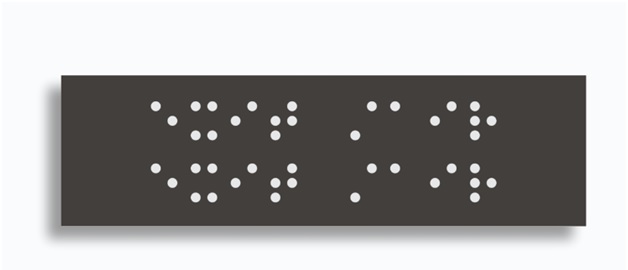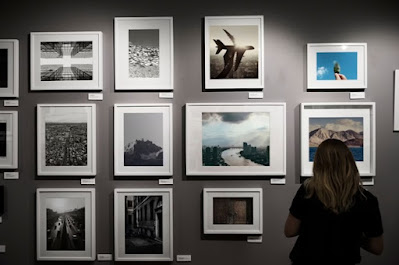Unexpected Ways to Use Custom Braille Signs in Various Locations & Settings
Imagine navigating a vibrant museum, captivated by ancient artifacts, but feeling a gap in the experience. Or picture browsing through your favorite grocery store, lost and frustrated amidst countless labels.
For millions of visually impaired individuals, these everyday scenarios can be isolating and challenging. But what if a simple solution could bridge the gap, fostering inclusivity and enriching everyone's experience?
This is where custom Braille signs come in, where they’re more than capable of bridging these boundaries and allowing the visually impaired to really trigger a spark in their minds and imaginations.
Forget sterile, generic signage. Today's custom Braille signs are more than just accessibility tools; they're creative canvases, storytelling companions, and sensory guides. Let's delve into unexpected ways these tactile wonders can transform familiar spaces:
Sensory Inputs in Museums
Museums contain a hoard of information about humanity’s history and past. The unfortunate thing about many museums, however, is that they require sight for one to be able to truly appreciate them.
How does this bode for the visually impaired? Oftentimes, they’re left out of this experience, and would have to rely on their companion to virtually describe and read out everything for them. But what if this could change with the simple addition of custom Braille signs, and some other interactive additions?
Here are a couple of examples for how museums can create a riveting experience even for those who are visually impaired:
- Interactive Exhibits: What if ancient sculptures could be paired with custom Braille signs describing their textures and stories. Blind visitors can "feel" the grooves of a Roman chariot wheel or the intricate scales of a dinosaur fossil, creating a multi-sensory journey through history.
- Self-Guided Exploration: Braille-labeled audio stations allow blind visitors to independently explore exhibits at their own pace. Custom signs with directional arrows and exhibit descriptions in Braille can really empower independence and enhance the museum experience for all.
- Tactile Masterpieces: Create custom Braille art installations, weaving raised patterns and textures into sculptures or paintings. This not only provides tangible art experiences for the visually impaired but also adds a unique dimension for sighted visitors.
Grocery Shopping, Reimagined
When it comes to shopping and trips to the grocery, a lot of these things are done for the visually impaired. Whether it’s the clerks or employees that help them stock their grocery carts, or it's their family or friends that lend a helping hand, it can be difficult for someone who’s visually impaired to go grocery shopping on their own.
If you’re a grocery store that wants to create a more inclusive environment, here are a couple of suggestions that might help empower those who are visually impaired and allow them the experience of getting their own groceries.
- Accessible Aisles: Imagine shelves adorned with custom Braille signs naming product categories and brands. Blind shoppers can navigate confidently, locate their favorite items, and regain the joy of independent grocery shopping.
- Ingredient Delights: Imagine recipe ingredients listed in both print and Braille on food packaging. Blind individuals can cook independently, experiment with new flavors, and rediscover the joy of preparing meals for themselves and loved ones.
- Inclusive Checkouts: Equip self-checkout stations with custom Braille keypads and audio prompts. This fosters independence and empowers blind individuals to complete their shopping experience with dignity and ease.
Clothing Stores
Clothing and fashion is something many of us pay a lot of attention to. We like dressing ourselves in clothes that make us not only feel good, but look good. The challenge with the visually impaired is that they’re unable to check and see what it is they look like.
For clothing stores, then, here are a couple of ways that they can implement custom Braille signs into their shopping experience.
- Braille tags embedded in fabric swatches: Imagine browsing a rack of shirts, fingertips tracing subtle textures woven into the fabric and Braille patches identifying material (silk, cotton, linen). This can help them identify the type of fabric that feels the most comfortable for them.
- Custom tags with size and fit descriptions: While, yes, one can always try on a piece of clothing to check their fit, it doesn’t necessarily give a visually impaired person an overview of what that fit would look like on them. Braille patches and Braille tags can convey details like "relaxed fit" or "slim cut," which can help with faster decision making as well as empower them to make confident outfit choices.
- Interactive display panels: Imagine tactile models of trendy garments alongside Braille descriptions of colors, patterns, and embellishments. Blind customers can explore styles hands-on, envision outfits, and confidently ask for specific items.
Community Centers
Community centers are populated with people from all walks of life, including the visually impaired. This is most likely why it’s important that these centers be ADA compliant when it comes to their facilities.
However, have you ever thought about how, exactly, you can further enhance the experience that those who are visually impaired could have in your facility? Here are a couple of suggestions:
- Braille directories and event schedule boards: Imagine essential information like room numbers, program details, and schedules presented in Braille alongside visual information, fostering independent participation.
- Interactive exhibits and displays: Setup local history exhibits with Braille descriptions alongside tactile models of landmarks or historical artifacts, creating an inclusive learning experience.
- Sensory gardens: Create raised plant identification tags in Braille, paired with aromatic herbs and textured foliage, allowing blind visitors to explore and connect with nature.
These are just a few examples of how custom Braille signs can be implemented in specific locations and industries to create a more inclusive and enriching experience for everyone.
By tapping into the power of touch and sensory storytelling, we can bridge the gap, empower individuals, and build a world where everyone feels welcome and able to fully engage with their surroundings.
Check out our catalog here at Braille Sign Pros today and discover how custom Braille signs can transform your space, spark imaginations, and leave a lasting impact on all who visit.
Remember, inclusivity is not just a checkbox; it's a journey of creativity and empathy. Let's rewrite the narrative of accessibility, one raised dot at a time, and build a future where everyone feels welcome, empowered, and part of the story.







Comments
Post a Comment